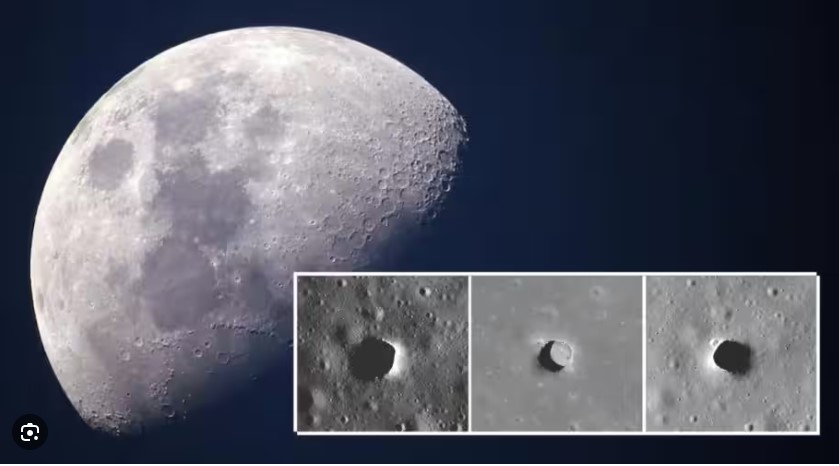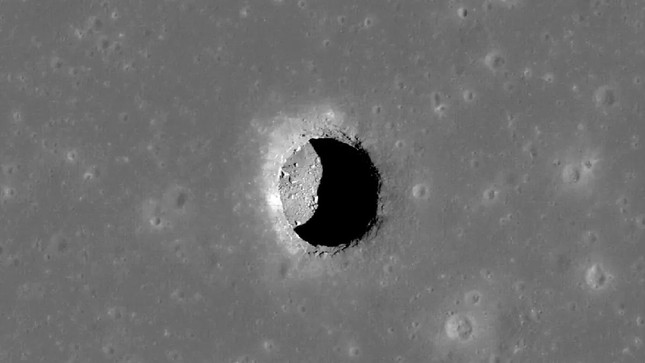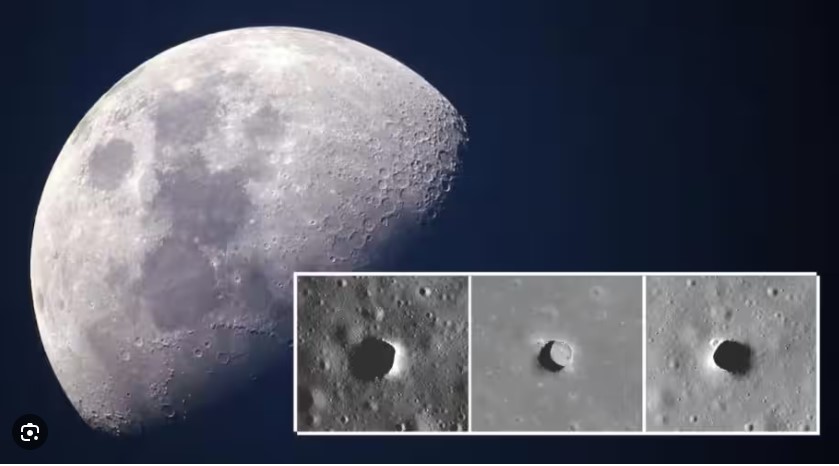The Moon has always held a special place in human imagination, from its influence on ancient mythologies to being the first destination for humanity’s space exploration efforts. Now, a groundbreaking discovery has reignited excitement and curiosity about our closest celestial neighbor. A massive 50km long cave has been discovered on the Moon, a find that could significantly impact future lunar missions and possibly even pave the way for human colonization.

This discovery is not only a monumental step in lunar research but also opens up new possibilities for understanding the Moon’s geological history, potential for sustaining life, and the role it could play in future space travel.
### **The Discovery of the 50km Lunar Cave**
In recent years, lunar exploration has advanced dramatically due to high-resolution satellite imaging and sophisticated technology. The Japan Aerospace Exploration Agency (JAXA), using data from their lunar orbiter SELENE (also known as Kaguya), made the stunning discovery of a cave stretching 50 kilometers (31 miles) beneath the Moon’s surface. This cave, located in the Marius Hills region, is thought to have been formed by ancient volcanic activity, which created what is known as a “lava tube.”

Lava tubes are long, hollow tunnels formed by flowing lava during volcanic eruptions. As the surface of the lava cools and hardens, the liquid lava underneath continues to flow, eventually leaving behind an empty tube. These structures are well-known on Earth, but the discovery of one on the Moon, and one of such significant length, offers extraordinary new opportunities.
### **Potential for Human Habitation**
One of the most exciting aspects of the discovery is the potential for using the cave as a natural shelter for future human missions to the Moon. Building a sustainable human presence on the lunar surface has always been a challenge, primarily due to the harsh environmental conditions. The Moon’s surface is exposed to extreme temperatures, cosmic radiation, and meteorite impacts, making long-term habitation difficult.

However, a 50km long cave could serve as a natural refuge, offering protection from these hazards. The cave’s thick walls would provide excellent insulation against temperature extremes, which can range from scorching 127°C (260°F) in sunlight to a frigid -173°C (-280°F) during the lunar night. More importantly, the cave would shield inhabitants from harmful cosmic rays and solar radiation, which are serious threats on the Moon due to its lack of a protective atmosphere.
### **Implications for Future Space Exploration**
The discovery of the lunar cave also opens up new possibilities for establishing a base that could support not just lunar exploration but also serve as a stepping stone for missions deeper into space. A cave of this size could potentially house facilities for research, living quarters, and even storage for essential resources like food, water, and equipment.
In the long term, this cave could become a central hub for launching missions to Mars and beyond. With NASA’s Artemis program aiming to return humans to the Moon by 2025, such a cave could be key to establishing a sustainable base that reduces the need for expensive and complex surface construction.
Furthermore, the Moon’s proximity to Earth makes it a prime candidate for developing technologies and strategies for deep-space exploration. A permanent lunar base could serve as a testbed for life support systems, habitat construction, and other technologies needed for human survival in space.
### **Scientific Opportunities**
Beyond its potential as a habitat, the discovery of the 50km cave offers valuable scientific opportunities. The cave could provide a treasure trove of information about the Moon’s geological history, especially its volcanic past. Studying the cave’s structure and composition could help scientists better understand the processes that shaped the Moon’s surface billions of years ago.
Lava tubes also have the potential to contain ice deposits or other volatile materials, which could be crucial for sustaining future lunar missions. Water is a critical resource for life, and finding substantial deposits on the Moon would make long-term habitation much more feasible. Water can also be split into hydrogen and oxygen, providing not only drinking water but also oxygen for breathing and hydrogen for rocket fuel.
Exploring this massive cave could also lead to discoveries about the Moon’s interior. There is still much we don’t know about the Moon’s subsurface structure, and this cave provides an unprecedented opportunity to explore beneath the lunar surface without the need for costly drilling or tunneling missions.
### **Challenges and Risks**
While the discovery of the 50km long cave presents incredible opportunities, there are also challenges and risks associated with exploring and potentially inhabiting such a structure.
Firstly, the cave’s stability is a major concern. Although lava tubes on Earth have been known to remain stable for millions of years, the Moon’s environment is different, and the structural integrity of the cave must be thoroughly studied before any human missions can be planned.
Secondly, entering and navigating the cave presents logistical challenges. The Moon’s low gravity could affect how vehicles and equipment operate inside the cave, and specialized technologies may be required to explore its depths safely. Rovers, drones, and other robotic explorers could be essential for mapping the cave and assessing its suitability for habitation.
Finally, there is the question of resources. While the cave offers protection, humans still need air, water, food, and power to survive. Transporting these resources from Earth is expensive and impractical for long-term missions, so scientists are exploring ways to use lunar resources. For example, the Moon’s regolith (the layer of loose material covering the surface) contains oxygen, and if ice deposits are found inside the cave, it could be used to generate water and breathable air.
The discovery of a 50km long cave on the Moon represents one of the most exciting breakthroughs in lunar exploration in recent years. Not only does it offer new insights into the Moon’s geological past, but it also holds immense potential for future human habitation and space exploration.
As space agencies like NASA, JAXA, and others plan their next steps for lunar missions, this cave could become a key part of humanity’s return to the Moon. With the possibility of using it as a natural shelter and resource hub, the dream of establishing a sustainable human presence on the Moon is closer than ever before.
This discovery marks a new era in space exploration, one that could shape the future of humanity’s quest to explore the stars.

